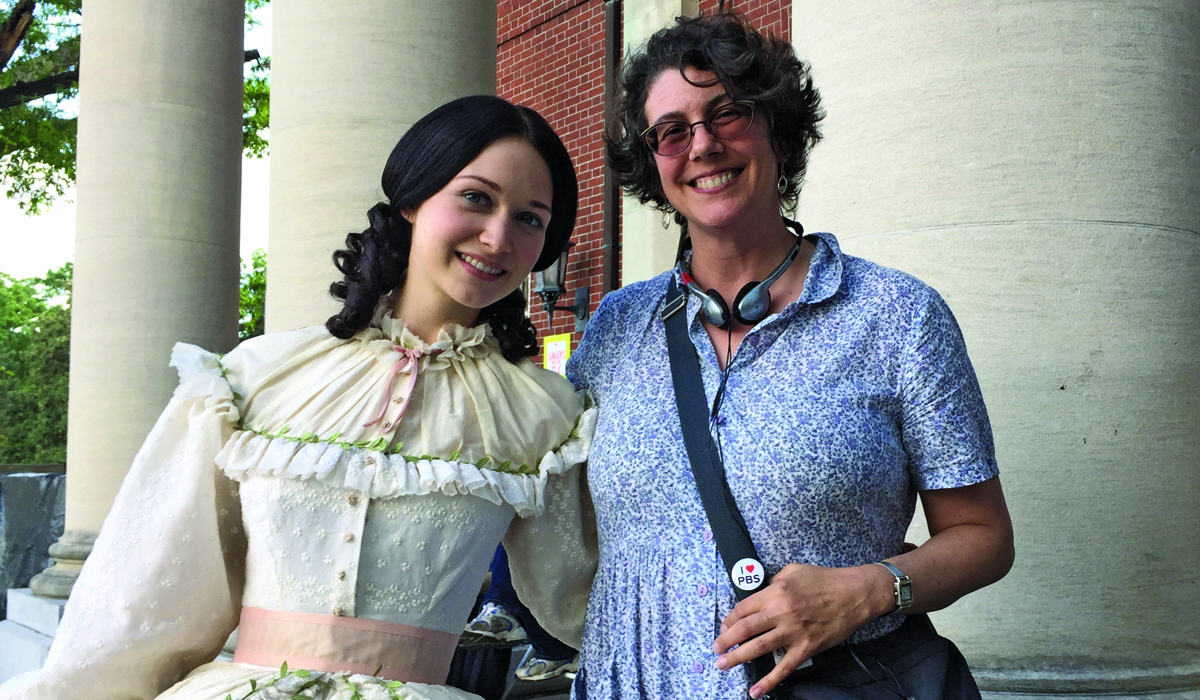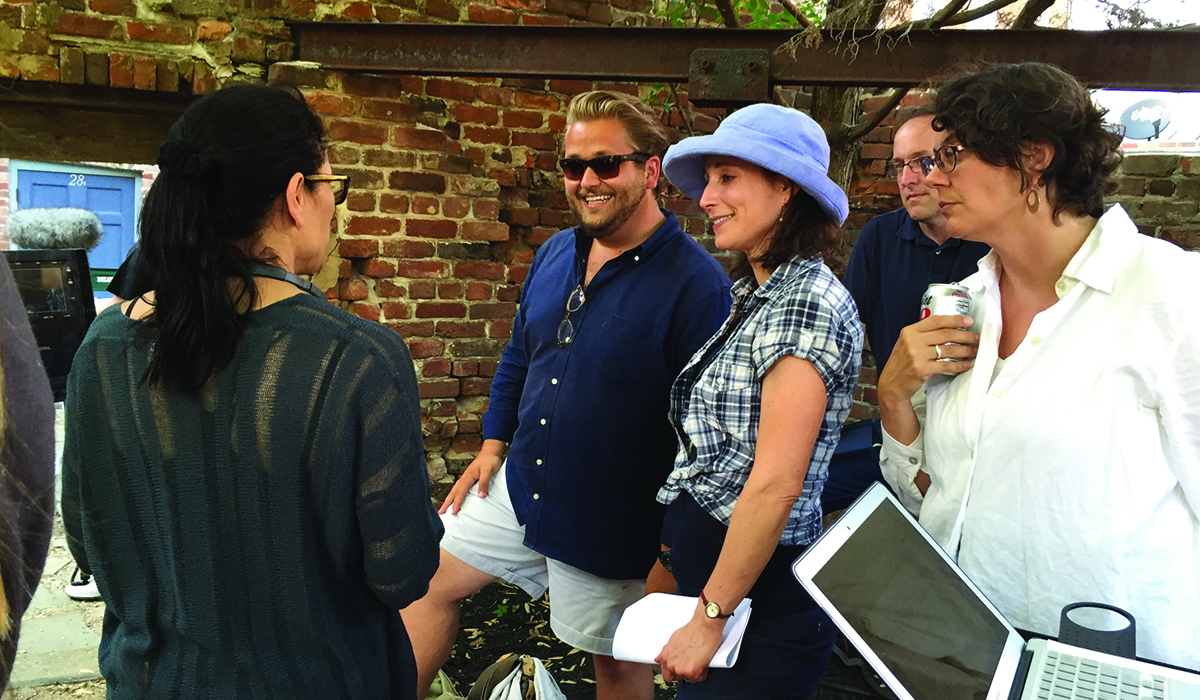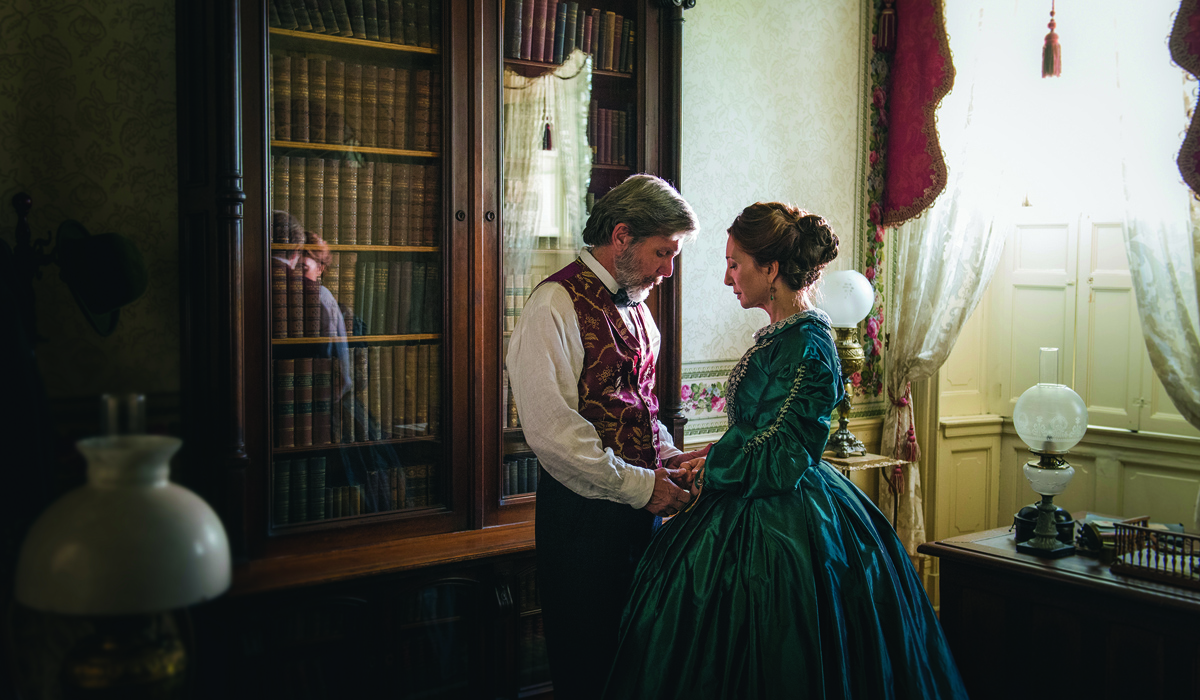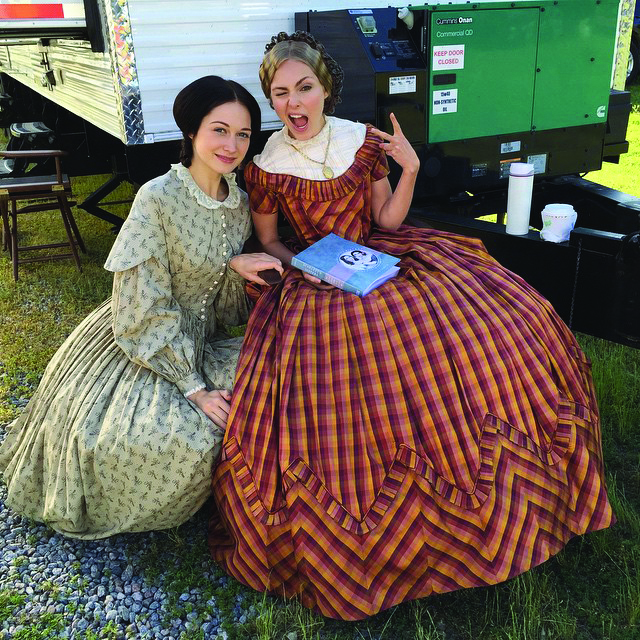- Editorial Offices
- 325 Brantly Hall
- Missoula, MT 59812
- (406) 243-2488
- themontanan@umontana.edu
- Icons By Maria Maldonado
UM History Professor Anya Jabour’s expertise plays a critical role in the new PBS Civil War drama Mercy Street




Anya Jabour has a pretty strict etiquette list for what a person should and should not do.
For instance, she notes, you should speak clearly and without hesitation. You should not fuss or fidget. The line from the base of your spine through your neck to the back of your head should be as straight as possible; your torso should form an S-curve. Don’t loll around, but also don’t be stiff. Be graceful. Avoid “unseemly” over-activity of the hands and arms. And whatever you do, don’t be haughty. It’s offensive.
In the twenty-first century, these directives seem laughable. But Jabour, a history professor at the University of Montana, created this detailed inventory for a group of people who actually need it: the cast members of Mercy Street, a new PBS drama set in the Civil War era.
As a historical consultant for the show, Jabour spent five weeks this past spring in Virginia working with the ensemble cast and at least 100 extras. Her job was to make the actors appear as authentic as possible, whether they were interacting with family members or with strangers, whether they were of a younger generation or an older one, African-American or white, Confederate or Union. And that meant providing them with the social guidelines of the time.
Mercy Street, which debuts in January, follows the lives of two volunteer nurses on opposite sides of the conflict. Mary Phinney is a New England abolitionist, and Emma Green is a young, upper-crust Confederate. Their worlds collide in Alexandria, Virginia, the occupied border town that has become home to all manner of people, including runaway slaves, displaced rebels, Union soldiers, and spies. Some characters are composites, others are based on real people.
And though it is television drama, the circumstances of war and the border-town setting guaranteed there was no need to amplify the action—all the elements of intrigue and tension were there. But the producers of the show did need to make sure the drama felt accurate down to the minutiae, and that’s where Jabour came in.
“They want to tell a story that has interesting characters and engaging storylines and drama and romance,” Jabour says. “And humor—because it’s so depressing you need some lightness, too. But it also has to be faithful to the time period.”
Jabour worked with the actors on following the social mores of the time, like how to walk in public. Women, for instance, wouldn’t walk unaccompanied. People of inferior status would walk on the right side and just behind their superiors. Party etiquette for the elite, especially, was precise. Gloves were to be worn while dancing but not when eating or drinking. Gents escorted ladies off the dance floor.
Jabour also helped provide guidance when it came to behaviors that were changing as a result of the war.
“You want the viewer be aware that there are these rules, which are mostly being followed,” she says. “That way, it highlights it more when those rules are being broken.
“Unlike me,” she adds, smiling, “the viewer is probably not sitting around reading etiquette books.”
When Jabour first started studying the South, she mostly was fascinated with the abolitionists. A sculpture of railroad track commemorating the Underground Railroad is displayed on the campus of Oberlin College, where she spent her undergrad years studying the reform movement. But over time, she became increasingly interested in the attitudes of young white women in the South and their reaction to the war—and how that reaction led to some inadvertent cultural shifts. She earned her master’s and doctorate degrees from Rice University in Texas, specializing in women, families, and children in the nineteenth-century South, and wrote her dissertation on a single family with twelve children.
“Six of them were daughters, and they all had these incredibly difficult coming-of-age experiences,” Jabour says. “So I got curious wondering if it was just this family or if it was typical.”
For her next project, Jabour studied young women’s coming-of-age experiences before and during the Civil War. She read the letters and diaries of about 300 Southern girls between ages fifteen and twenty-five, many of which she found in a large collection at the University of North Carolina in Chapel Hill. The voices she discovered in the pages represent a particular group—white and elite—because that’s who had privilege.
“African-Americans were, first of all, prohibited legally from learning to read and write,” Jabour says. “But even if they did learn, they did not belong to the kind of families who had the opportunity or motivation to save their [writings]. People who have wealth and stability are more likely to save those things and think they are valuable.”
The result of Jabour’s research is the 2007 book Scarlett’s Sisters: Young Women in the Old South, with “Scarlett” being a reference to the fictional Southern belle star of Gone with the Wind, Scarlett O’Hara. The book provides a look into how elite Southern women who were already poised for change—they were getting an education but didn’t have an outlet for it—found a catalyst during the Civil War. The fervor of rebellion against the Union made it easier for Confederate women to step outside their usual social parameters. The new roles involved more choices, more independence from men, and even independence from a life that involved slaveholding.
A few years ago, Scarlett’s Sisters ended up in the hands of producer Lisa Q. Wolfinger. She was collaborating with David Zabel, best known as an executive producer for the medical drama ER, on what Wolfinger hoped would be a hospital show set during the Civil War. But during her research, she came across the story of Alexandria’s occupation in the Civil War and discovered the story of the Green family, who had once owned a luxury hotel there before it was taken over by Union soldiers and turned into a hospital. The house-turned-hospital storyline gave her a slightly different story—a medical drama that also delved into the domestic lives of the characters. Scarlett’s Sisters was the perfect fit for addressing that aspect.
“We knew that the family, the Greens, who owned the hotel, had actually stayed in town throughout the war,” Wolfinger says. “And so all those elements combined really inspired us to start digging. Our research team and I read many, many, many books, including some original source material. And I came across Anya Jabour’s Scarlett’s Sisters. And I thought she could help us bring to life the Green family and specifically the younger daughters.”
The advising process involved two steps. During the script-writing phase, Jabour served as one of eight advisers—each of whom had their own area of expertise—who looked at scripts and provided notes to the writers. Once the scripts were vetted, Jabour and other advisers flew to the set of the show in Virginia this past spring and worked with the actors in rehearsal and blocking before they shot each scene.
In addition to her work on Scarlett’s Sisters, Jabour completed another project about children in the South during the Civil War, including African-American and white boys and girls. Part of that work entailed reading former slaves’ stories collected during Franklin Roosevelt’s New Deal initiatives. Many of the extras on Mercy Street were children, so Jabour also was able to bring her knowledge of their lives to the table.
“I was looking for an expert who could really advise our actors in all the minutiae,” Wolfinger says. “What was wonderful about Anya was that she not only gave us specifics for the Green family, but we actually loved her so much we kept her longer. We used her in some of the exterior scenes where she advised the background extras on social norms.”
 Mercy Street illuminates the complex roles African-Americans played during the war. Some stayed with their owners but demanded a better life, like the Greens’ servant, Belinda. Others ran away and became “contraband” in the tumultuous free zone of Alexandria.
Mercy Street illuminates the complex roles African-Americans played during the war. Some stayed with their owners but demanded a better life, like the Greens’ servant, Belinda. Others ran away and became “contraband” in the tumultuous free zone of Alexandria.
“Theirs was a whole different experience with the Civil War,” Jabour says. “They had a chance to escape and find their husband or child who was sold away from them fifteen years earlier. That was another group who were ready to take on this opportunity.”
There’s one scene in Mercy Street where Confederate matriarch Jane Green—mother to Emma Green—starts to become unhinged. The Civil War is in full swing. Union soldiers have taken over the Mansion House Hotel in Alexandria, owned by Jane and her husband, John Green. Jane is horrified as men cart her expensive belongings from the former luxury hotel as they convert it into a Union hospital. Her once stable and elite lifestyle is being pulled out from under her.
“We see her out on the lawn chasing the soldiers and telling them to be careful with this particular chest that has all these miniature ivory elephant heads on it,” says actor Donna Murphy, who plays Jane Green. “It’s an heirloom that belonged to her husband’s [family]. She’s giving the soldiers all this information about the furniture that they really couldn’t care less about.”
Murphy, who also played Mary Todd Lincoln in a TNT film, says Jabour taught her how to maintain her character as a proud woman of the Old South. She learned dining etiquette, funeral decorum, and how to handle crossing a muddy street in a hoop skirt. [Press one hand against the side of the hoop so it lifts at an angle]. They also worked on breaking convention.
“We talked about where boundaries would get pushed,” Murphy says. “I wanted to show that she’s unsettled and a little desperate, and we talked about how that might happen—raising her voice in a certain way or talking in a tone that was not even. As a woman you would never wear your feelings. I say never—that’s the intention. But they are human first and Southern second, so it was great to talk about where those things might happen.”
“It was such a luxury,” she adds, “to have Anya there, knowing she was watching. It allowed me to be in the moment.”
Jane Green is desperate and unsettled, but in Mercy Street, the Green girls are embracing the culture change.
The central story of two women becoming nurses is a prime example. Nursing wasn’t a career yet, and those who did it were usually convalescent soldiers or African-American servants. The idea of an upper-class white woman doing the job was controversial. Jabour worked with the writers and actors to bring that idea sharply into focus.
“There were lots of questions about Emma Green,” Jabour says. “About her desire to work as a nurse in a military hospital, and the way her family would have likely responded, and how she might have eventually persuaded them to let her take this step toward what was really a very new departure.”
For PBS viewers, Mercy Street might end up becoming another cult hit like Downton Abbey. But for Jabour, working on the show was an education.
“It was energizing and exhausting,” she says. “It was really fascinating for me to learn about the process. I learned about props and set dec[orating] and about what the wardrobe people do, the light people, and sound people. I learned about film positions I didn’t know existed.”
Jabour will turn her experience on Mercy Street into an education for others. She is set to teach a course at UM’s School of Extended and Lifelong Learning in January using the show as a guide to explore the way the Civil War changed people’s lives in often surprising ways.
“One of the things I have written about is the way loyalty to the Confederacy—although it’s not a radical political position—opened up these opportunities for young Southern white women to engage in politics and to rebel against gender convention,” she says. “It gave them a legitimate outlet for political opinions. Historians debate sort of endlessly about whether wars in general and the Civil War in particular really was a watershed, or if it was a blip in history. And there are excellent arguments to be made on both sides.
“My contention is that for younger women at least, the Civil War really was a watershed. They were at a life stage when they were ready to embrace change.”